Growth Yield and Quality of Turmeric Curcuma longa L Cultivated on Dark red Soil Gray Soil and Red Soil in Okinawa Japan
Bạn đang xem bản rút gọn của tài liệu. Xem và tải ngay bản đầy đủ của tài liệu tại đây (319.41 KB, 6 trang )
Plant Production Science
ISSN: 1343-943X (Print) 1349-1008 (Online) Journal homepage: />
Growth, Yield and Quality of Turmeric (Curcuma
longa L.) Cultivated on Dark-red Soil, Gray Soil and
Red Soil in Okinawa, Japan
Md. Amzad Hossain & Yukio Ishimine
To cite this article: Md. Amzad Hossain & Yukio Ishimine (2005) Growth, Yield and Quality of
Turmeric (Curcuma�longa L.) Cultivated on Dark-red Soil, Gray Soil and Red Soil in Okinawa,
Japan, Plant Production Science, 8:4, 482-486, DOI: 10.1626/pps.8.482
To link to this article: />
© 2005 Crop Science Society of Japan
Published online: 03 Dec 2015.
Submit your article to this journal
Article views: 2056
Citing articles: 21 View citing articles
Full Terms & Conditions of access and use can be found at
/>
Plant Prod. Sci. 8(4) : 482 ź 486 (2005)
Growth, Yield and Quality of Turmeric (Curcuma longa L.)
Cultivated on Dark-red Soil, Gray Soil and Red Soil
in Okinawa, Japan
Md. Amzad Hossain and Yukio Ishimine
(Subtropical Field Science Center, Faculty of Agriculture, University of the Ryukyus, Senbaru 1,
Nishihara Cho, Okinawa 903-0213, Japan)
Abstract : We evaluated growth, yield and quality of turmeric (Curcuma longa L.) cultivated in pots with dark-red
soil (pH 5.2), gray soil (pH 7.4) and red soil (pH 4.4) in Okinawa, Japan. The soils were collected from the 50-cm
deep layer of the fields. We did not use any chemicals or organic fertilizers. Turmeric cultivated on dark-red soil
had the highest plant height, root biomass and shoot biomass as compared with that cultivated on other soil
types. Turmeric on dark-red soil had the highest yield with favorable color of the deep yellow and high curcumin
content (0.20%). Protein content of turmeric in dark-red soil was 5.2%, which was around 40% higher than
that in other soil types. Turmeric cultivated on dark-red and gray soils had a fat content 71% higher than that in
red soil. The content of Ca, K and Mg was the highest when turmeric was cultivated on gray soil, and Fe was the
highest when cultivated on dark-red soil. To gain a high yield and high contents of curcumin, fat, protein and
Fe, we should cultivate turmeric in dark-red soil in Okinawa. We could not recognize the specific soil factor(s)
required for high yielding and high quality of turmeric; however, it seems that a proper combination of soil
factors, nutrients and/or pH level may be necessary to gain a high yield and high quality.
Key words : Curcumin content, Fat content, Mineral content, Protein, Turmeric color.
ǽTurmeric (Curcuma longa L.) is a popular spice in
many countries of Asia (Hermann and Martine, 1991;
Ishimine et al., 2003). It is now important in medical
science because curcumin and volatile oils of turmeric
rhizomes have anti-infl ammatory, antimutagen,
anticancer, antibacterial, anti-oxidant, antifungal,
antiparasitic and detox properties (Hermann and
Martine, 1991; Osawa et al., 1995; Sugiyama, 1996;
Nakamura et al., 1998). These components also
promote liver and kidney functions, and alleviate
biliary disorders, diabetic and hepatic disorders
(Hermann and Martin, 1991). Calcium, Mg, Fe,
protein and fat are also considered to be important
quality parameters of turmeric. Various supplements
and drinks derived from the turmeric are widely being
used for keeping good health (Hossain et al., 2005a,
2005b).
It is general that growth, yield and quality of a
crop species vary with the soil type, and the kind and
balance of available nutrients (Oya, 1972; Oya et
al., 1977). A particular crop species grows well in a
particular soil type with a balance of nutrients (Oya,
1972). Curcuma longa L. is the most valuable medicinal
plant among the turmeric species. Consumers and
manufacturing companies buy turmeric not consider
where and in which soil it was cultivated, and what the
content of medicinal components in it was. Research
on crop cultivation under the local climatic and
edaphic factors is important to achieve a high yield
with a high quality (Aoi et al., 1988; Akamine et al.,
1995; Ishimine et al., 2003). Turmeric is commercially
cultivated in Okinawa, Japan, which is mainly occupied
by dark-red soil, gray soil and red soil (Akamine et al.,
1994; Ishimine et al., 2003). In our previous studies,
the effects of planting depth, time and pattern, and
seed size of turmeric on yield and quality of turmeric
were examined (Ishimine et al., 2003, 2004; Hossain et
al., 2005a, 2005b). We conducted the present study to
determine the effects of different soil types on growth,
yield and quality of turmeric.
Materials and Methods
1.ǽAnalysis of physical and chemical properties of soil
ǽDark-red soil and gray soil were collected from the
50-cm deep layer of the fields of the Subtropical Field
Science Center, University of the Ryukyus, Japan, and
red soil was collected at the same depth in the field
of Nago Agricultural Experiment Station, Okinawa.
Soil physical properties were determined with a Kõhn
Type Soil Sedimentation Apparatus, soil pH in H2O
with a TOA pH meter HM-20S (Toa Electronic Ltd.
Japan), and mineral contents of soils using Inductively
Coupled Plasma Spectrometer (ICPS-2000, Shimadzu
Co. Ltd.). Total carbon content was measured by
Received 21 September 2004. Accepted 26 January 2005. Corresponding author: Y. Ishimine (, fax
+81-98-895-8741).
Note: Data are means of 3 replications. Data were recorded on the dry weight basis.
0.903
0.924
32.841
30.918
24.316
30.941
16.919
4.433
0.211
0.958
2.ǽTurmeric cultivation and data collection
ǽThe glasshouse experiment was conducted from
April 20, 1999 to January 28, 2000. Wagner pots (0.05
m2) were filled with 10 kg of air-dried soil for each pot.
One seed-rhizome (30 g) per pot was planted at the
depth of 6 cm. Ten pots were used for each soil, and
the pots were placed randomly. We did not apply any
chemical or organic fertilizers to determine the actual
effects of physical and chemical properties of soil
on growth, yield and quality parameters of turmeric.
Water was applied adequately everyday to maintain
optimum soil moisture level for proper seedling
emergence and plant growth.
ǽPlant height and the number of tillers were
recorded at 205 days after planting when main shoot
completed leaf formation. Plants were harvested when
shoots completely withered. Leaves, shoots, roots and
rhizomes were collected, and the plant parts were
oven-dried at 80 ºC for 48 hr and weighed.
0.051
0.080
483
using Shimadzu gas chromatograph (Soil GS-8A) and
Sumigraph (NC-90A, Shimadzu). Nitrate nitrogen
(NO 3 -N) and ammonium nitrogen (NH 4 -N) were
calculated from nitrogen content, which measured
according to Kjeldahl method. Apparent density of
the dark-red soil, gray soil and red soil was measured
on the dry weight basis. Table 1 shows the physical and
chemical properties of soils.
20.437
ǽ3.605
0.048
ǽ15.002
0.756
4.597
0.158
5.422
0.414
ǽǽ4.149
ǽǽ15.840
42.887
10.316
ǽ55.903
Red soil
Gray soil
102.356
2604.153
279.301
0.257
5.263
0.230
0.535
ǽ6.387
Dark-red soil
ǽ30.520
ǽǽ24.976
ǽǽ5.366
0.253
soil
soil
soil
type
soil
soil
soil
soil
0.518
0.059
%
%
%
µg g
µg g
µg g
µg g
µg g
µg g
µg g
Soil
µg g
-1
7.426
0.070
2765.067
26.622
0.867
57.243
ǽ7.334
ǽ2.927
0.068
ǽ36.682
%
%
soil
23.942
g cm-3
density
%
%
(H2O)
sand
sand
Clay
Coarse
pH
C
NH4-N
NO3-N
-1
S
-1
P
-1
Fe
-1
Al
-1
Mg
-1
-1
Ca
K
Na
Tableǽ1.ǽChemical and physical properties of dark-red soil, gray soil and red soil in Okinawa, Japan.
Fine
Silt
Apparent
Hossain and Ishimine źź Effect of Soil Types on Yield and Quality of Turmeric
3.ǽAnalysis of turmeric compositions
ǽRhizomes were sliced and dried at 40 ºC for 48
hours, and ground finely. Powders of 10 plants were
mixed together for each soil treatment, and all the
quality parameters were determined for three samples
of each soil. Mineral contents of turmeric powder
were detected with a Shimadzu AA-660, protein
was calculated from nitrogen contents, which were
measured according to the Kjeldahl method and
total fat was extracted with a Soxhlet apparatus using
diethylether. Protein factor 6.25 was used. Curcumin
content was measured by HPLC (Shimadzu Co. Ltd.).
4.ǽData management and statistical analysis
ǽMean values were calculated for physical and
chemical properties of soils and turmeric as shown in
the Tables 1 and 3. Mean and standard deviation (SD)
of 10 replications were determined using analysis of
variance (ANOVA) for growth and yield parameters
of turmeric, and Fisher's protected least significance
difference (LSD) test at the 5% level of significance for
comparison of the means.
Results
1.ǽGrowth and yield of turmeric
ǽTurmeric plant height did not vary signifi cantly
with the soil type, but it was slightly higher in darkred soil. The number of tillers and leaf biomass were
484
Plant Production Science Vol.8, 2005
not statistically different with the soil type, but red soil
produced the lowest tiller number and leaf biomass
(Table 2). Root biomass of turmeric significantly varied
with the soil type. Dark-red soil produced significantly
highest root biomass of turmeric followed by gray soil
(Table 2). Shoot biomass and yield were significantly
higher when turmeric was cultivated on dark-red soil
than in gray and red soils.
2.ǽQuality parameters
ǽDaughter rhizomes were bigger when turmeric was
cultivated on dark-red soil than in the red or gray soil,
although the rhizomes were same in size (data not
presented). Color of turmeric powder was a favorable
yellow when cultivated on dark-red soil followed by
gray soil (Fig. 1). The curcumin content was the
highest (0.20%) in the turmeric cultivated on darkred soil followed by gray soil (0.10%). Protein content
of turmeric in dark-red was the highest (5.2%), which
was 40% higher than that in other soil types (Table 3).
Total fat content was 3.6% in the turmeric cultivated
on dark-red and gray soil, and was 2.1% in red soil
(Table 3).
ǽSodium content of turmeric was the highest when
cultivated on red soil followed by gray soil, whereas K
content was the highest when cultivated on gray soil
followed by red soil (Table 3). The calcium content
of turmeric in gray soil was the highest, which was
2 to 3 times greater than that in other soil types.
Turmeric contained 6.3 µ g g-1 Mg when planted in gray
soil followed by red soil, whereas Fe content was the
highest when cultivated on dark-red soil.
Tableǽ2.ǽComparison of growth parameters and yield of turmeric cultivated on dark-red soil, gray soil and red soil.
Soil type
Plant
height (cm)
Number of
tillers plant-1
Leaf biomass
(g plant-1)
Root biomass
(g plant-1)
*Shoot biomass
(g plant-1)
#Yield
(g plant-1)
Dark-red soil
127.8Ă6.6a
2.2Ă0.4a
11.2Ă1.2a
12.1Ă1.2a
33.8Ă4.3a
39.5Ă3.2a
Gray soil
121.4Ă6.0a
2.2Ă0.4a
11.2Ă1.5a
ǽ7.0Ă0.5b
28.6Ă2.0b
27.5Ă2.5b
Red soil
119.4Ă7.4a
1.6Ă0.5a
ǽ9.2Ă1.5a
ǽ4.4Ă0.8c
28.5Ă3.7b
30.2Ă2.6b
Note: Data are means ĂSD of 10 replications. Data with the same letter within each column are not significantly
different at the 5% level, as determined by Fisher’s protected least signifi cant difference (LSD) test. *, Total
aboveground parts (pseudostem or stem plus leaf); # rhizome dry weight.
Fig.ǽ1.ǽColor of powder of turmeric cultivated on dark-red soil (DS), gray soil (GS) and red soil
(RS) in Okinawa, Japan. TD, powder of turmeric cultivated on dark-red soil; TG, powder of
turmeric cultivated on gray soil; TR, powder of turmeric cultivated on red soil.
485
Hossain and Ishimine źź Effect of Soil Types on Yield and Quality of Turmeric
Tableǽ3.ǽQuality parameters of powder of turmeric cultivated on dark-red soil, gray soil and red soil in Okinawa, Japan.
Soil
type
Na
µ g g-1
powder
K
µ g g-1
powder
Ca
µ g g-1
powder
Mg
µ g g-1
powder
Fe
µ g g-1
powder
Protein
%
Fat
%
Ash
%
Crude fiber Curcumin
%
%
Dark-red soil
0.414
6.228
0.858
2.801
0.376
5.206
3.625
5.303
4.190
0.20
Gray soil
0.784
16.824
1.862
6.304
0.239
3.402
3.643
5.136
3.514
0.10
Red soil
1.289
10.096
0.512
4.209
0.156
3.363
2.149
4.020
3.505
0.06
Note: Data are means of 3 replications. Data were recorded on the dry weight basis.
Discussion
1.ǽGrowth and yield
ǽIt is difficult to explain the effects of individual or
combined soil nutrient(s) on growth of turmeric plant
in this study. Similarly, Oya (1972) reported that no
general tendencies in the relationship between the
plant growth and the concentrations of K, Ca and
Mg were found in different soils. It is assume that the
lowest P and K contents, and the high NO 3-N and
NH4-N content of dark-red soil are comparatively good
combinations, which resulted in higher vegetative
growth (Table 2). Gray soil had higher/highest
NO 3-N and NH 4-N contents, but did not produce
a large shoot biomass like dark-red soil, indicating
that there was an interaction among the nutrient
contents, which influenced plant growth. Similarly,
other studies (Mazid, 1993; McCrea et al., 2004; Hao
and Papadopoulos, 2004) reported that unbalanced
nutrient resulted in lower growth and yield of plants.
Dark-red soil was comparatively loose (apparent
density was the lowest (Table 1)) and it contained
optimum moisture, which resulted in greater root and
vegetative growth (Table 2). Similarly, Houlbrooke
et al. (1997) reported that root biomass and shoot
biomass of ryegrass (Lolium perenne) were increased
by the lower soil bulk (apparent) density. The waterlogging condition continued for some time in red
and gray soils after water application, but it was not
found in dark-red soil. In addition, red soil became
compact when it dried, and gray soil remained wet for
a longer time. Therefore, it is assumed that aeration
and microbial activities were poor in red and gray
soil, which probably caused in lower vegetative and
reproductive growth of turmeric.
ǽA large shoot biomass of turmeric on dark-red soil
resulted in a higher yield, which is in agreement with
the results of our previous studies (Ishimine et al.,
2003; Hossain et al., 2005a). Rhizomes grew bigger
in dark-red soil because this soil was comparatively
loose. Turmeric shoots on dark-red soil remained
green for a longer period, resulting in a longer period
of photosynthesis and increased the yield (Table 2).
Similarly, Zaman et al. (2001) reported that a longer
period of photosynthesis was the key factor of higher
rice-yield.
2.ǽQuality parameters
ǽThe color of turmeric powder was the deepest yellow
when cultivated on dark-red soil followed by gray soil
(Fig. 1). We could not determine the specific elements
required for preferable coloring of turmeric. However,
a proper combination of minerals, nutrients and soil
pH is required. The curcumin, protein and total fat
contents of turmeric were highest when cultivated on
dark-red soil, perhaps due to optimum mineral and
soil pH levels.
ǽSodium content of turmeric was the highest when
cultivated on red soil though this soil did not contain
the largest amount of Na. Turmeric in gray soil had
the highest K, Ca and Mg contents, because this soil
contained the largest amount of K, Ca and Mg (Table
1 and 3). Iron (Fe) content of turmeric was the highest
in dark-red soil followed by gray soil. We did not find
any clear relationship between the mineral content
in soil and that of turmeric powder. However, it is
assumed that balanced fertilization (naturally existed
in soil), soil pH and soil physiological properties were
necessary for higher mineral content of turmeric.
Other studies reported that yield and quality of
crops are positively and/or negatively correlated
with physical, chemical and nutrient properties of
soil (Oya, 1972; Miyazawa et al., 2004). From the
results/information of this study and other studies, it
is assumed that a certain ratio of minerals, a balanced
fertilization, a limited soil pH and a certain soil
physical properties are required to increase yield and
quality of a specific plant species.
Conclusions
ǽThe highest yield with favorable color and high
curcumin content were achieved when turmeric was
cultivated on dark-red soil. Protein and fat content of
turmeric were about two times higher when cultivated
on dark-red soil than other soil types. To achieve a high
yield, and high curcumin, fat, protein and Fe contents
of turmeric we should cultivate the plants on darkred soil in Okinawa, Japan. It is assumed that a wide
range of soil pH is probably favorable for turmeric
cultivation. In addition, a certain combination of soil
factors, nutrients and/or pH level may be necessary
to increase the quality of turmeric, which should be
examined in future experiments.
486
Plant Production Science Vol.8, 2005
Acknowledgement
ǽThe authors would like to thank Associate Professor
Yoshinobu Kawamitsu, Associate Professor Makoto
Kitou, Professor Yasuhiro Kawamoto, Professor Fujiya
Hongo, Mr. Kazutoshi Kinjo, Mr. Susumu Mizumachi
and Ms Kuniyoshi Megumi, Faculty of Agriculture,
University of the Ryukyus, and Ryukyu Bio-resource
Co. Ltd. for using their laboratories to determine
soil chemical and physical properties, and quality
parameters of turmeric.
References
Akamine, H., Goya, A., Tomoyose, T., Kanna, K., Fukuti, S. and
Kinjo, K. 1994. Studies on characteristics and cultivation of
turmeric. (1) Plant characteristics of turmeric and effect of
fertilizer. Sci. Bull. Agr. Univ. Ryukyus 41 : 335-341**.
Akamine, H., Ishimine, Y. and Murayama, S. 1995. Studies on
characteristics and cultivation of turmeric (Curcuma longa L.).
(2) Effects of shading on the growth and yield of turmeric.
Sci. Bull. Agr. Univ. Ryukyus 42 : 133-137**.
Aoi, K., Yamamoto, H., Nagoe, T. and Kusunoki, T. 1988.
Production technology of medicinal plant turmeric. Agric.
Hortic. 63 : 1317-1322*.
Hao, X. and Papadopoulos, A. P. 2004. Effects of calcium and
magnesium on plant growth, biomass partitioning and fruit
yield of winter greenhouse tomato. HortScience 39 : 512-515.
Hermann, P. T. A. and Martin, A. W. 1991. Pharmacology of
Curcuma longa. Planta Med. 57 : 1-7.
Houlbrooke, D. J., Thome, E. R., Chapman, R. and Mclay, C. D.
A. 1997. A study of the effects of soil bulk density on root and
shoot growth of different ryegrass lines. New Zealand J. Agric.
Res. 40 : 429-415.
Hossain, M. A., Ishimine, Y., Akamine, H. and Motomura, K.
2005a. Effects of Seed Rhizome Size on Growth and Yield of
Turmeric (Curcuma longa L.). Plant Prod. Sci 8 : 86-94.
Hossain, M. A., Ishimine, Y., Motomura, K. and Akamine, H.
2005b. Effects of Planting Pattern and Spacing on Growth
and Yield of Turmeric (Curcuma longa L.). Plant Prod. Sci. 8 :
95-105.
Ishimine, Y., Hossain, M. A., Ishimine, Y. and Murayama, S. 2003.
Optimal planting depth for (Curcuma longa L.) cultivation in
Dark-red soil in Okinawa Island, Southern Japan. Plant Prod.
Sci. 6 : 83-89.
Ishimine, Y., Hossain, M. A., Motomura, K., Akamine, H. and
Hirayama, T. 2004. Effects of planting date on emergence,
growth and yield of turmeric (Curcuma longa L.) in Okinawa
Prefecture, Southern Japan. Jpn. J. Trop. Agric. 48 : 10-16.
Miyazawa, K., Tsuji, H., Yamagata, M., Nakano, H. and
Nakamoto T. 2004. Response of soybean, suagar beet
and spring wheat to combination of reduced tillage and
fertilization practices. Plant Prod. Sci. 7 : 77-87.
McCrea, A. R., Trueman, I. C. and Fullen M. A. 2004. Factors
relating to soil fertility and species diversity in both seminatural and created meadows in the west midlands of
England. European. J. Soil. Sci. 55 : 335-348.
Mazid M. A. 1993. Sulfur and nitrogen for sustainable rainfed
lowland rice. PhD thesis. University Philippines at Los Banos.
Nakamura, Y., Ohto, Y., Murakami, A., Osawa, T. and
Ohigashi, H. 1998. Inhibitory effects of curcumin and
tetrahydrocurcuminoids on tumor promoter-induced reactive
oxygen species generation in leukocytes in vitro and in vivo.
Jpn. J. Cancer Res. 89 : 361-370.
Osawa, T., Sugiyama, Y., Inayoshi, M. and Kawakishi, S. 1995.
Antioxidative activity of tetrahydrocurcuminoids. Biosci.
Biotech. Biochem. 59 : 1609-1612.
Oya, K. 1972. Evaluation of potassium availability of four
Michigan soils. Sci. Bull. Coll. Agr. Univ. Ryukyus 19 : 123-257.
Oya, K., Tokashiki, Y. and Ishimine, Y. 1977. Effects of potassium
fertilization on the yields of sweet potato autumn crop grown
on a calcareous soil of Okinawa. Sci. Bull. Coll. Agr. Univ.
Ryukyus 24 : 191-197.
Sarker, M. A. Z., Murayama, S., Ishimine, Y. and Nakamura, I.
2001. Physio-morphological characters of F1 hybrids of rice
(Oryza sativa L.) in Japonica-Indica crosses. II. Heterosis for
leaf area and dry matter accumulation. Plant Prod. Sci. 4 :
202-209.
Sugiyama, Y., Kawakishi, S. and Osawa, T. 1996. Involvement
of the β -diketone moiety in the antioxidative mechanism of
tetrahydrocurcumin. Biochem. Pharmaco. 52 : 519-525.
ǽ* In Japanese
** In Japanese with English abstract
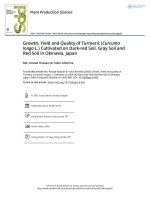
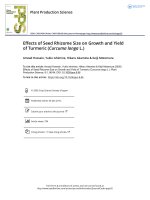
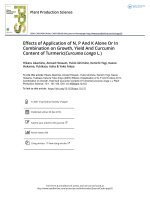

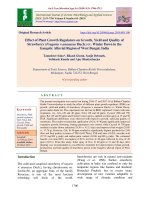
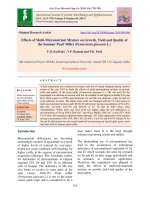
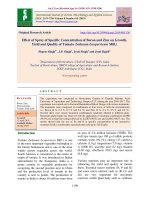
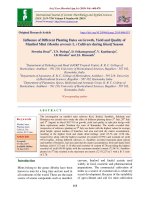
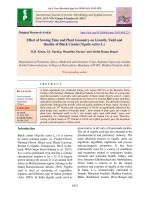
![Effect of fertility levels and stress mitigating chemicals on nutrient uptake, yield and quality of mungbean [Vigna radiata (L.) Wilczek] under loamy sand soil of Rajasthan](https://media.store123doc.com/images/document/2020_01/09/medium_ftp1578562755.jpg)